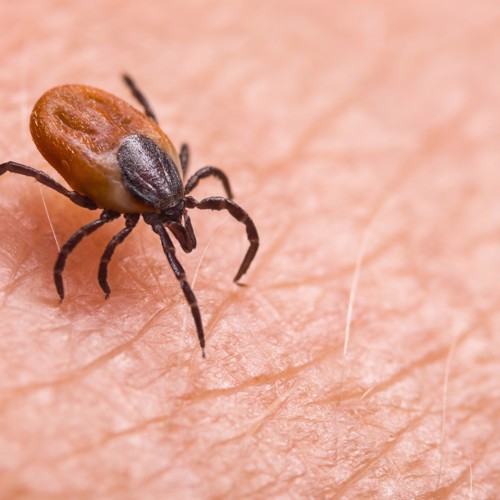Tick borne encephalitis
NO
PHARMACEUTICAL INFLUENCE
Tick borne encephalitis

It’s a busy duty list and you have a call with a concerned parent. Anna has just returned from a seaside holiday in Dorset. Her 5 yr old son Alex has a low grade fever of 38C, and is a bit off colour. Anna has read about a ‘new deadly virus’ carried by ticks. “The article says it has been found in Dorset’ she says. ‘I’m sorry Doctor, I’m sure it’s not related but I’m panicking. What do you think?’
A recent press release from the UK Health Security Agency announced tick-borne encephalitis virus is now likely to be present in England. Whilst this may sound alarming, the good news is that according to the UKHSA ‘surveillance suggests that tick-borne encephalitis virus is very uncommon in the UK and that the risk to the general population is very low’ (1)
Tick-borne encephalitis virus (TBEV) causes a wide spectrum of disease. A whopping 2/3 of those infected will be asymptomatic (2). For the rest, symptoms range from a mild flu-like illness to severe meningitis/ encephalitis. Clinical TBE (TBEV-Eur subtype) has a biphasic presentation. There is an average incubation period of 7 days from tick bite (foodborne incubation shorter at 4 days). Then non-specific symptoms such as fever, fatigue, headache, myalgia and nausea develop. After around 5 days people feel better, and symptoms subside for about a week. 20-30% of those with clinical TBE will then go on to develop CNS symptoms. These include meningitis, meningoencephalitis, myelitis, paralysis and radiculitis. There is a case fatality rate of <2%. Age is a risk factor for more severe disease, with higher rates of mortality and chronic neurological symptoms in those over 60.
Importantly, it is not a brand new virus. TBE is endemic in some rural and forested parts of Europe, China, Japan and eastern Russia. Travellers to these areas have long been encouraged to consider vaccination against TBE (via private travel clinics- not currently available on the NHS). Reassuringly the subtype found in Europe is associated with lower severity of disease.
TBE is primarily transmitted by infected ticks. It can also be caught through the consumption of unpasteurised milk from infected animals (e.g. sheep, goats). Human to human transmission is rare, but possible through transplants, blood products and breastfeeding. Of note, aside from using the same vector TBE it is unrelated to Lyme disease, which is caused by the bacterium Borrelia burgdorferi.
The numbers of confirmed cases of TBE in the UK are currently extremely small. Since 2019 there have been a grand total of 4 cases thought to originate from within the UK. 2 probable cases (serological detection) and 2 confirmed cases (PCR). The last confirmed case was reported in England in October 2022 and was linked to the Yorkshire moors. There have been occasional cases of travellers returning with infection acquired abroad. Since 2019 the virus has been identified in ticks in the East of England, Hampshire, Dorset and North Yorkshire.
Theories about how TBEV has reached the UK include the potential for migratory birds to spread infected ticks from endemic areas in Europe, and possible introduction through domestic animal movement. In 2012 the PETS travel scheme was altered, removing the requirement for compulsory tick treatment of companion animals (e.g. dogs) entering the UK from Europe. The UK based species of tick Ixodes ricinus acts both as a reservoir and vector. It is found in woodlands, moor-land and some urban parks. Climate change may also be implicated in northerly spread.
How do we treat TBE? The mainstay of defence is prevention. People going to forested areas should consider covering skin (the NHS style icons recommend tucking socks into trousers) and using insect repellent. Always check hair and skin on return and promptly remove any ticks. The public can find advice about how to safely remove ticks on the NHS site. There is currently no routine vaccination programme within the UK. However, watch this space as the Joint Committee on Vaccination and Immunisation (JCVI) has been asked to consider whether vaccination of high risk groups (e.g. forestry workers) is needed. There is no specific treatment for infection-supportive care only. Neurological symptoms are akin to those seen for other causes of meningitis/ encephalitis and would trigger secondary care referral for work up and treatment. Red flags include severe headache, neck stiffness, photophobia, altered consciousness, sudden behaviour change and new onset seizure.
Takeaway message- TBE remains very rare in the UK. It is very unlikely that Alex’s symptoms are related. Be alert to the possibility in those who have been to forested areas of high tick prevalence. Don’t forget the differential of Lyme disease in those presenting with tick bites!
References:
Dr Laura Darby
18th May 2023
Join us at one of our upcoming courses or live webinars

Recent NB Blogs
Need an immediate update? – all our courses are available on demand
Did you find this useful?
You can quickly add CPD to your account by writing a reflective note about the Tick borne encephalitis post you've read.
Log in to your NB Dashboard and use the 'Add Reflective Note' button at the bottom of a blog entry to add your note.

